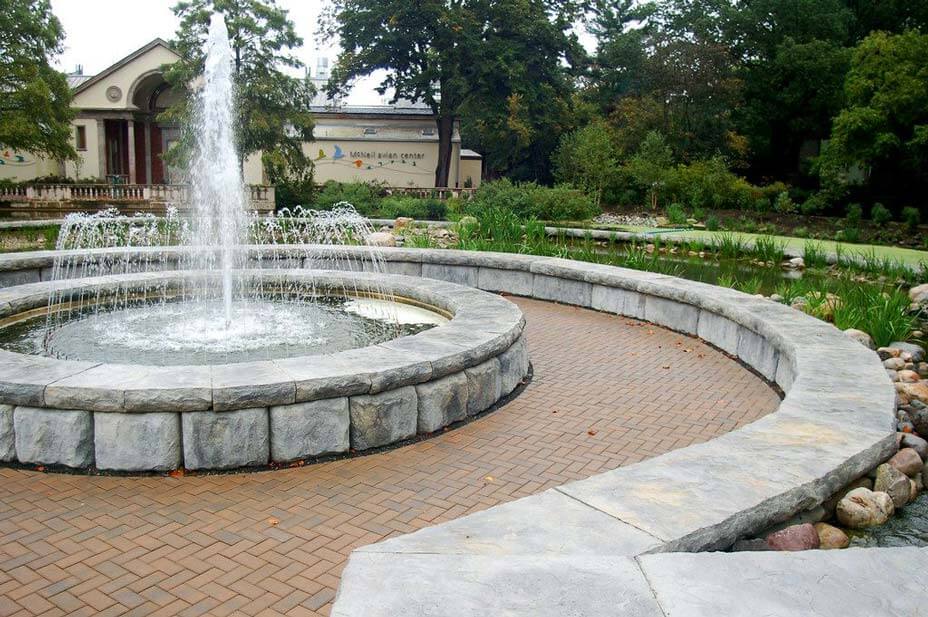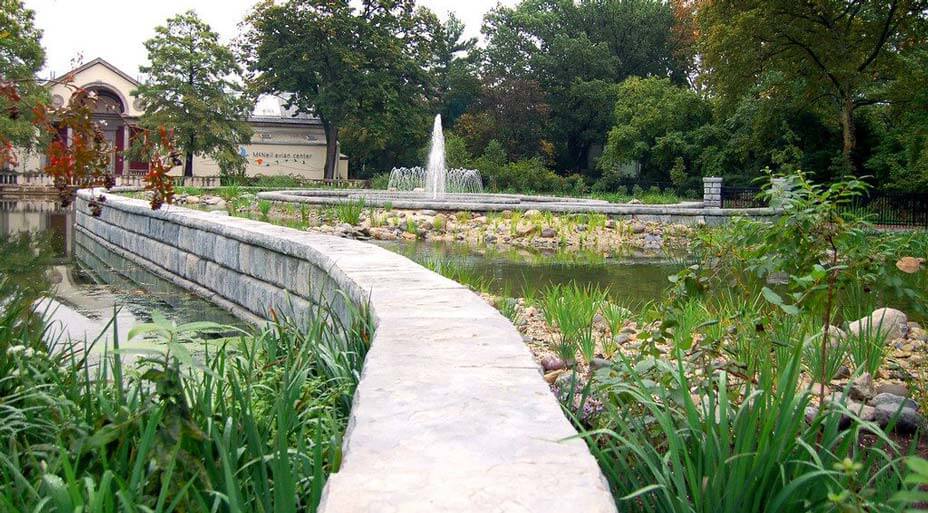Precast Freestanding Walls For Benches And Fountains at Zoo
Zoo reduces water use with help from Redi-Rock freestanding walls
THE CHALLENGE
Responsible use of water is a major priority in landscape designs across the country-and the Philadelphia Zoo is leading the way in reducing its water use and inspiring visitors to do the same.
"With our recent initiatives, the Zoo has already reduced water consumption by almost half," explained Chris Waldron, Sustainable Operations Manager at the Philadelphia Zoo.
One of the biggest projects the zoo has undertaken to reduce its water use by half was the renovation of it's biggest water-guzzling attraction-Bird Lake. This man-made lake is a popular attraction where visitors can take swan-shaped boats for a spin.

Redi-Rock freestanding walls and caps were used to create seat walls and ponds throughout this renovation project at the Philadelphia Zoo.
"We calculated that Bird Lake used more water on a daily basis than any other system, as we had to run fresh water in to minimize algae growth and maintain water quality. So that became a primary target in reducing our water use even further," said Waldron.
The goal of the Bird Pond renovation project was to develop an "innovative man-made wetland around Bird Lake that would maintain good water quality while greatly reducing the need for water use," explained Nina Bisbee, Vice President of Facilities at the Philadelphia Zoo.
"The Zoo is committed to reducing our footprint on the world, through using less energy, water and other resources," Bisbee said.

The new ponds, which are lined with Redi-Rock walls, helped the zoo reduce its water use by 50%.
THE SOLUTION
With these goals in mind, the zoo turned to PS&S, a design firm with experience in creating man-made wetlands. Finding a material to contain the wetland was a major factor of the design.
Explained Project Manager Donald Sharp of PS&S: "Redi-Rock was chosen to contain the wetland areas with a cost-effective structural solution that is compatible with the historic architectural fabric of the Zoo."
Redi-Rock is a large, modular block system known for creating structural and aesthetic solutions for retaining and freestanding walls. Manufactured locally by Smith Wilbert, each block weighs about one ton, harnessing the power of gravity to build tall walls that require no reinforcement in many applications. In addition, Redi-Rock is available in multiple natural textures to match the aesthetics of a project. For this project, designers chose the Limestone texture to match the historic architecture of the zoo.
Made of architectural-grade precast concrete, Redi-Rock is a natural product that is incredibly durable-making it a great choice for projects that require sustainable solutions.
The design of the project included creating a series of pond areas with a special soil mix to filter the water.

Redi-Rock freestanding walls are a great way to create seat walls!
"The system is like a natural wetland, filtering the water through beds of wetland plants. This way, the zoo can re-circulate water in the lake rather than continuously adding new water," explained Bisbee.
The filtration system was built in the center of Bird Lake-accessible by a brick paver path that leads to the fountain area. Water from the lake is pumped to the fountain lined with Redi-Rock blocks where the filtration process begins. Several additional Redi-Rock ponds step down from the highest point at the fountain, each filtering the water through soil and plants before the water is reintroduced to the lake.
4125 square feet (383.2 square meters) of Redi-Rock freestanding and column blocks from Smith Wilbert were used to line the fountain, ponds, and part of Bird Lake. Most of the walls were 3.5 to 6 feet (1.1 to 1.8 meters) tall. These walls featured Limestone texture on both sides and were all topped with Redi-Rock cap blocks.
An interesting design element was the use of Redi-Rock Garden blocks in this project. Garden blocks have a trough or void in the top which is usually used to create space for soil and plants. However, the designers of this project utilized Garden blocks in a unique way. Because one side of the Redi-Rock modular block walls acted as the side of the ponds, the pond liners were pulled up and tucked into the trough, then secured in place by placing a Redi-Rock Cap block on top.
The pond area re-opened in 2011 and the zoo reports that guests have responded positively to this new and beautiful area that surrounds Bird Lake. Plus, reducing water use by almost 50 percent is a definite plus for the zoo.
PROJECT DETAILS
Project: Philadelphia Zoo Walls and Pond #163 Customer: Philadelphia Zoo Engineer: PS&S Manufacturer: Smith Wilbert Inc. Installer: Blood Good Landscape Corporation; Haverstick - Borthwick Construction Co. Location: Philadelphia, Pennsylvania Year Built: 2010-2011
PRODUCTS FEATURED IN THIS CASE STUDY
Freestanding Blocks - Redi-Rock freestanding blocks are textured on both sides, giving above-grade walls an unbeatable, finished look for any project you design.
Cap Blocks - Redi-Rock cap blocks are the perfect way to finish a retaining wall, freestanding wall, or column.
Limestone Texture Blocks - One of the beautiful face texture options offered on Redi-Rock blocks.